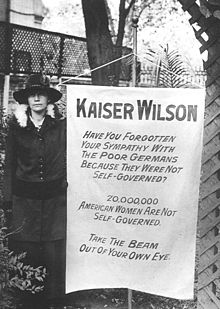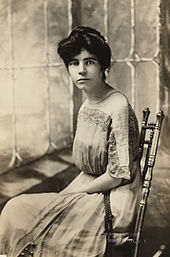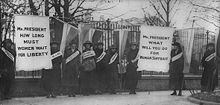Alice Paul
Alice Stokes Paul (* 11. January 1885 in Mount Laurel , New Jersey; † 9. July 1977 in Moorestown, New Jersey) was a leading American suffragette and women's rights activist . Together with Lucy Burns , a close friend, and a number of other women, she led the successful struggle for women's suffrage in the United States between 1912 and 1920 . The 19th Amendment to the United States Constitution , which guaranteed women the right to vote, was passed by the US Congress in 1920 . Even after that, Alice Paul remained active in women's politics until a few years before her death.
Life
Youth in Pennsylvania
Alice Paul was born to a wealthy Quaker family from Pennsylvania . She grew up on her parents' farm, Paulsdale , and, as she herself said, her childhood shaped her later in life. While working on the farm, she learned to appreciate the qualities of hard work and perseverance. But also the liberal attitude towards life of the parents William and Tacie Paul , who raised their daughter in the conviction of gender equality, had an important influence on Alice Paul. The mother Tacie Paul was involved in the National American Woman Suffrage Association (NAWSA) (German: National American Women's Suffrage Association ) for women's suffrage. She introduced her daughter to suffragette meetings at an early age.
- “When the Quakers were founded, gender equality was one of their principles. I never have any other idea, this principle has always been there. ” (Alice Paul in an interview in 1974).
Long years of training
After graduating from school in 1901, Alice Paul studied at Swarthmore College , which she graduated in 1905 with a Bachelor of Science in biology. This was followed by a degree in social work at the New York School of Philanthropy ( Columbia University ) and another degree in sociology at the University of Pennsylvania , from which she graduated in 1907 with a Master of Arts .
In the same year Paul went to England for three years to study social work at the University of Birmingham and the London School of Economics . After her return to the USA in 1910, she received her doctorate in sociology from the University of Pennsylvania in 1912 with the topic “The legal situation of women in Pennsylvania” .
After the 19th Amendment was ratified in 1920, Paul resumed his studies in 1922, studying law at the Washington College of Law . In 1928 she received her doctorate in private law .
Radical women's rights activists in England
During her time in England, under the influence of the English suffragettes around Emmeline Pankhurst , Paul changed from a Quaker daughter who was interested in women politics but reluctant to become a radical fighter for women's suffrage. A chance encounter with Pankhurst's daughter Christabel , whom she observed at a rally in 1908, made Paul join the Women's Social and Political Union ( WSPU ). Here she also met the American Lucy Burns, with whom she soon became a close friend.
Paul was heavily involved in campaigns for women's suffrage, she took part in protests in front of the entrance to parliament and, according to her own statements, smashed a total of 48 window panes. Paul was arrested multiple times and sentenced to three prison terms. She and the other suffragettes who were arrested went on hunger strikes to protest the detention, and the administration responded with brutal force-feeding .
Back in the USA
Paul returned to the USA in 1910 and was determined to breathe new life into the American suffragette movement with the radical ideas of English women.
- A contentious policy brings success. Agitation has roused England from its torpor, and English women today speak of the time they will vote instead of the time their children will vote, as they did a year or two ago.
In 1912 Paul joined NAWSA and was appointed chairman of the congressional committee that was supposed to take care of one of NAWSA's subordinate goals, a constitutional amendment for women's suffrage at the federal level. The main goal of NAWSA and its chairman, Carrie Chapman Catt , was still to gradually achieve women's suffrage in the individual states.
In Washington Paul met Lucy Burns, who had meanwhile also returned to the USA. After several unsuccessful meetings with future President Woodrow Wilson , who was uninterested in their cause , Paul and Burns organized a grand parade in Washington which took place on March 3, 1913 - the day of Wilson's inauguration - and ended in disaster. Under the eyes of the idle police, an angry mob attacked the parading women and injured many of them. However, this event brought the suffragettes the previously insufficient attention of the press.
The National Woman's Party

After Paul and Burns along with some other women in the Congressional Union for Woman Suffrage (CUWS) had split because of political differences of the NAWSA, they founded in 1915 the radical National Woman's Party ( NWP ) (dt. National Women's Party ) to targeted Protests and vigils ( Silent Sentinels ) in front of the White House to make the public aware of their goal. The relationship between NAWSA and the NWP was tense from the start, and the NAWSA sharply criticized the actions of the NWP as being too radical.
When the USA entered the First World War , the situation of the NWP suffragettes worsened. Their vigils in front of the White House were insulted as traitors, some were physically assaulted and arrested by the police. Alice Paul and 33 other women were sentenced to several months' imprisonment on flimsy grounds in October 1917 and imprisoned under extreme conditions in the Occoquan Workhouse women's prison (now the Lorton Correctional Complex ).
The detainees immediately went on a hunger strike, and the prison authorities brutally force-fed them. The prison administration used systematic violence against the women's rights activists in order to break their will. The attempt to admit Alice Paul to psychiatry in order to have her declared insane, however, failed because of the psychiatrist's opinion.
When the press found out about the conditions of Paul and her colleagues in prison, it began to report extensively. Protests against the treatment of women in prison rose, and even the hitherto reticent NAWSA declared war on the government. As a result, the imprisoned NWP activists were released from custody at the end of November 1917. The sentences were later declared unconstitutional by the United States Supreme Court .
Under the political pressure of events, Woodrow Wilson announced in January 1918 that he would support women's suffrage as a "measure of war". A week later, Congress voted narrowly in favor of the amendment. Since the draft was rejected in the Senate, the NWP started a large-scale campaign before the Senate elections in 1918, so that the majority in the newly elected Senate supported women's suffrage. The 19th Amendment to the Constitution was ratified on August 26, 1920 .
Another fight for equality
Unlike many suffragettes who have now withdrawn, Alice Paul continued to work in the field of women's rights, as she saw this subject as far from being over. In 1923 she drafted the Equal Rights Amendment (ERA), which was supposed to bring women - in addition to equal voting rights - full equality in the constitution. The draft was finally approved by Congress in 1972. Since the required number of states had not approved by the 1982 deadline, the Equal Rights Amendment was not incorporated into the constitution. Alice Paul did not live to see this defeat.
- “I never doubted that equality was the way to go. Most of the reforms and problems are complex. But for me, simple equality has nothing complicated. " (Alice Paul 1972 in an interview)
In the late 1920s, Paul expanded the activities of the NWP. During several trips abroad to South America and Europe, she founded the World Woman's Party (WWP) based in Geneva . The organization later renamed itself World Woman's Party for Equal Rights . With the outbreak of World War II , WWP headquarters became a refuge for a number of political refugees, but moved back to Washington in 1941 under pressure from Nazi Germany. On the initiative of WWP 1946 was the UN Commission on the Status of Women ( Commission on the Status of Women (CSW) set up) that the UN Economic and Social Council is assigned.
In the 1950s and 1960s, Paul returned to increasing women's rights in the United States. At the age of 79, she led the NWP's campaign to amend the 1964 Civil Rights Act to prohibit gender discrimination . When she was over 80, she still took part in protest demonstrations against the Vietnam War. After suffering a heart attack in 1974, however, she was unable to continue working. In 1977 Alice Paul died of heart failure.
When asked by a journalist why she had devoted her entire life to women's rights, Alice Paul replied with a wisdom she had learned as a child on her parents' farm:
- "Once you've put your hand on the plow, you can't stop until you've reached the end of the furrow."
Trivia
- The story of the struggle for the 19th amendment to the Constitution was filmed in 2004 by the director Katja von Garnier under the title Iron Jawed Angels . In 2005 Swarthmore College named a new dormitory after Alice Paul.
- For her 131st birthday on January 11, 2016, Google created a doodle for her.
reception
Alice Paul - Der Weg ins Licht is a documentary feature film by the German director Katja von Garnier from 2004. It deals with the story of the US fighters for women's suffrage and two of their activists, Alice Paul and Lucy Burns, from 1912 to 1912 1920.
The Belmont-Paul Women's Equality National Monument is named after her.
Remarks
- ^ "When the Quakers were founded ... one of their principles was and is equality of sexes. So I had never any other idea ... the principle was always there. "
- ↑ "The militant policy is bringing success ... the agitation has brought England out of her lethargy, and women of England are now talking of the time when they will vote, instead of the time when their children would vote, as was the custom a year or two back. "
- ↑ Lakewood Public Library: Women in History ( Memento June 19, 2006 in the Internet Archive )
- ↑ "I never doubted did equal right thing the right direction. Most reforms, most problems are complicated. But to me there is nothing complicated about ordinary equality. "
- ↑ " When you put your hand to the plow, you can't put it down until you get to the end of the row. "
- ↑ Doodle for Alice Paul
literature
- Amy E. Butler: Two Paths to Equality. Alice Paul and Ethel M. Smith in the ERA Debate, 1921-1929, State University of New York Press, Albany, NY 2002, ISBN 0-585-47319-6 .
- Kristina Dumbeck: Leaders of Women's Suffrage. Lucent Books, San Diego, CA 2001.
- Linda G. Ford: Iron-Jawed Angels. The Suffrage Militancy of the National Woman's Party 1912-1920. University Press of America, Lanham, MD / New York, NY / London 1991.
- Christine A. Lunardini: From Equal Suffrage to Equal Rights. Alice Paul and the National Woman's Party, 1910-1928. New York University Press, New York, NY 1986, ISBN 0-8147-5022-2 (Ph Dissertation Princeton University 1981, 322 pages).
- Mary Walton: A woman's crusade. Alice Paul and the battle for the ballot. Palgrave MacMillan, New York, Basingstoke 2010. ISBN 978-0-230-61175-7 .
- Victor Grossman : Rebel Girls: Portraits of 34 American Women (= New Small Library , Volume 185). Papyrossa, Cologne 2012, pp. 158–171, ISBN 978-3-89438-501-9 .
- JD Zahniser: Alice Paul: Claiming Power, New York: Oxford University Press 2019, ISBN 9780190932930 .
Web links
- Alice Paul Institute in Mount Laurel (English)
- Alice Paul. In: FemBio. Women's biography research (with references and citations).
- Fan site Katja von Garnier about Alice Paul
- Lakewood Public Library: Who is who - Alice Paul (English)
- Alice Paul in the database of Find a Grave (English)
| personal data | |
|---|---|
| SURNAME | Paul, Alice |
| ALTERNATIVE NAMES | Stokes Paul, Alice |
| BRIEF DESCRIPTION | American suffragette and feminist |
| DATE OF BIRTH | January 11, 1885 |
| PLACE OF BIRTH | Mount Laurel , New Jersey |
| DATE OF DEATH | July 9, 1977 |
| Place of death | Moorestown, New Jersey |





